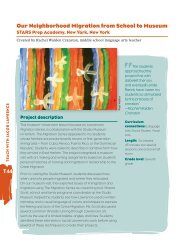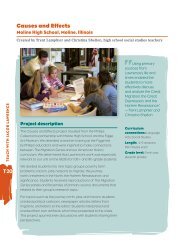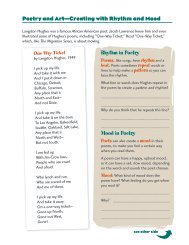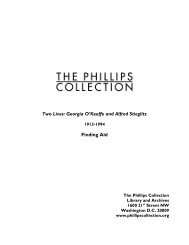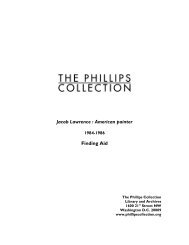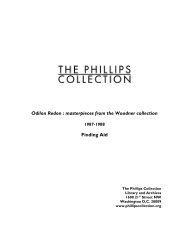[Collection Title] - The Phillips Collection
[Collection Title] - The Phillips Collection
[Collection Title] - The Phillips Collection
Create successful ePaper yourself
Turn your PDF publications into a flip-book with our unique Google optimized e-Paper software.
Renoir to Rothko: <strong>The</strong> Eye of Duncan <strong>Phillips</strong>1999-2000Finding Aid<strong>The</strong> <strong>Phillips</strong> <strong>Collection</strong>Library and Archives1600 21 st Street NWWashington D.C. 20009www.phillipscollection.org
CURATORIAL RECORDS IN THE PHILLIPS COLLECTIONARCHIVESINTRODUCTORY INFORMATION<strong>Collection</strong> <strong>Title</strong>: Renoir to Rothko: <strong>The</strong> Eye of Duncan <strong>Phillips</strong>; exhibition recordsAuthor/Creator: <strong>The</strong> <strong>Phillips</strong> <strong>Collection</strong> Curatorial Department. Eliza E. Rathbone, ChiefCurator, and Elizabeth (Beth) Hutton Turner, CuratorSize: 1.25 linear feet; 3 document boxesBulk Dates: 1998-2000Inclusive Dates: 1984-2002Repository: <strong>The</strong> <strong>Phillips</strong> <strong>Collection</strong> ArchivesINFORMATION FOR USERS OF THE COLLECTIONRestrictions: <strong>The</strong> collection contains restricted materials. Please contact Karen Schneider,Librarian, with any questions regarding access.Handling Requirements: Care should be taken when handling the audio diskette housed inBox 1, Folder 14; for usage of this CD, see head librarian. <strong>The</strong> oversized preliminary floorplan/elevation drawing housed in Box 2, Folder 14, must be carefully unfolded for viewing.Preferred Citation: <strong>The</strong> <strong>Phillips</strong> <strong>Collection</strong> Archives, Washington, D.C.Publication and Reproduction Rights: See Karen Schneider, Librarian, for furtherinformation and to obtain required forms.ABSTRACTRenoir to Rothko: <strong>The</strong> Eye of Duncan <strong>Phillips</strong> (1999-2000) exhibition records contain materialscreated and collected by the Curatorial Department, <strong>The</strong> <strong>Phillips</strong> <strong>Collection</strong>, during the courseof organizing the exhibition. Included are research, catalogue, and exhibition planning files thatdocument the preparation and logistics for the show.HISTORICAL NOTELaughlin <strong>Phillips</strong> (1924-2010), a founder of Washingtonian magazine, succeeded his motherMarjorie <strong>Phillips</strong> to become director of <strong>The</strong> <strong>Phillips</strong> <strong>Collection</strong> in 1972, a tenure that spannedtwo decades from 1972-1992. By the time that Laughlin sold his magazine in 1979, America‟sfirst museum of modern art was beginning to show the common problems that beset museums.<strong>The</strong> museum that founder Duncan <strong>Phillips</strong> created was in need of modernization. In the 1980sthe museum underwent a period of intense growth and activity led by Laughlin <strong>Phillips</strong>, whooversaw the collection‟s remarkable transformation from a home filled with paintings to aprofessional museum.2
As director, Laughlin <strong>Phillips</strong> established a research office headed by Martha Carey and herassistant Sarah Martin. A laborious inventory was conducted by staff from 1983 to 1985, withthe resulting 1985 book <strong>The</strong> <strong>Phillips</strong> <strong>Collection</strong>: A Summary Catalogue, the first publication to listall artworks in the permanent collection. <strong>The</strong>ir efforts were succeeded by research curatorErika Passantino, who worked with a research team to prepare a larger scholarly catalogue ofthe collection that would not only provide full documentation of its most important holdingsbut serve as an interpretive analysis of Duncan <strong>Phillips</strong>‟s importance as a writer, collector, andinfluence on the cultural history of modernism in America.As the 21 st century approached, these efforts inspired the exhibition that presented a newcontextual understanding of Duncan <strong>Phillips</strong> and his role in the art world: Renoir to Rothko: <strong>The</strong>Eye of Duncan <strong>Phillips</strong> and the scholarly catalogue that was published entitled <strong>The</strong> Eye of Duncan<strong>Phillips</strong>: A <strong>Collection</strong> in the Making.SCOPE AND CONTENTS OF THE COLLECTIONCuratorial records in this record group document the research, planning, and activities of stafffrom 1998 to 2000 for the exhibition entitled Renoir to Rothko: <strong>The</strong> Eye of Duncan <strong>Phillips</strong>. Builtupon the knowledge gained from two decades of research and study of the permanentcollection, Renoir to Rothko: <strong>The</strong> Eye of Duncan <strong>Phillips</strong>, was the most comprehensive andambitious exhibition in the history of <strong>The</strong> <strong>Phillips</strong> <strong>Collection</strong>. <strong>The</strong> exhibition filled the entiremuseum with 350 works drawn from the 2,500 American and European paintings, sculptures,and works on paper in the permanent collection, presented in refurbished galleries in the 1897Georgian Revival house and the Goh Annex. Arranged chronologically by date of acquisition(and thematically), it explored milestones in <strong>Phillips</strong>‟s collecting and the evolution of hisaesthetic taste over a period of fifty years, from his early purchases in 1916 until his death in1966. <strong>Phillips</strong>‟s correspondence, journals, manuscripts, and ledgers, along with historicalphotographs were displayed in archival cases to amplify exhibition content.Organized by <strong>The</strong> <strong>Phillips</strong> <strong>Collection</strong>, the show opened at the museum on September 25, 1999,and remained on view through January 23, 2000. <strong>The</strong> exhibition was organized by Eliza E.Rathbone, Chief Curator, and Beth Turner, Curator, under the directorship of Jay Gates. Ledby Rathbone and Turner, the entire curatorial staff of <strong>The</strong> <strong>Phillips</strong> <strong>Collection</strong> contributed to theexhibition, its installation, presentation, archival materials, and audio guide. Corporatesponsorship for the exhibition came from Merrill Lynch. <strong>The</strong> show did not travel.<strong>The</strong> exhibition was scheduled to coincide with the September 1999 completion date of thelavish catalogue entitled <strong>The</strong> Eye of Duncan <strong>Phillips</strong>: A <strong>Collection</strong> in the Making, published by <strong>The</strong><strong>Phillips</strong> <strong>Collection</strong> in association with Yale University Press. Edited by Erika D. Passantino, thebook is both a selected survey of the major European and American works in <strong>The</strong> <strong>Phillips</strong><strong>Collection</strong> and a study in the development of Duncan <strong>Phillips</strong> as critic, collector, and patron.Records in this collection consist mostly of the research and exhibition planning files of chiefcurator Eliza Rathbone, and curator Beth Turner, as well as a few documents related to the3
catalogue. <strong>The</strong> exhibition began to take shape in a series of planning meetings in 1998 to setthe themes and select works to best illustrate those themes. As evidenced in the records, anearly working title for the exhibition was: Modern Art at the Millenium: <strong>The</strong> Eye of Duncan<strong>Phillips</strong>. Meetings were also held with the facilities department to schedule the renovationneeded to refurbish the building (both its interior and exterior spaces) and the galleries, sincethe entire museum was to be given over to the exhibition. <strong>The</strong> files also document fundingefforts; educational and public programs including the Duncan <strong>Phillips</strong> Lectures, Artful Evenings,teacher programs, school tours, and gallery talks; special events, including the Duncan <strong>Phillips</strong>award presented to Leonard A. Lauder; press coverage; the show‟s audio guide; and adocumentary film on Duncan <strong>Phillips</strong> produced by WETA for national broadcast on PBS.CUSTODIAL HISTORY AND ACQUISITION INFORMATIONThis collection is owned by <strong>The</strong> <strong>Phillips</strong> <strong>Collection</strong>, and was accessioned from the curators‟offices in accordance with the museum‟s records schedule.PROCESSING AND DESCRIPTION INFORMATIONDate Processed: July 2011Processed By: Colleen Hennessey, Archives Assistant, supervised by Karen Schneider,LibrarianProcessing Notes: After an initial survey of the collection, some duplicate materials wereidentified and a number of documents were determined to be of no future reference value forthe collection. In discussions with the librarian, approval was given to photocopydocumentation, weed duplicate documents (retaining those with hand-written notes), anddiscard selected drafts. Boxes and folders containing restricted materials were marked with ared dot (see note above re „restrictions‟). Folder headings were maintained when possible, butwere re-written in some cases for greater clarity and accuracy. Metal fasteners were removedand replaced with plastic clips when needed. Post Its were photocopied if necessary, orotherwise removed. All documents were re-foldered into acid free folders.Finding Aid Written By: Colleen Hennessey, Archives Assistant, supervised by KarenSchneider, LibrarianRELATED MATERIAL<strong>The</strong> <strong>Phillips</strong> <strong>Collection</strong> Archives includes Duncan <strong>Phillips</strong>‟s correspondence, manuscripts, andjournals as well as the correspondence of Marjorie <strong>Phillips</strong> and other staff members associatedwith the early years of the museum. In addition, exhibition material assembled by the researchoffice is now housed in <strong>The</strong> <strong>Phillips</strong> <strong>Collection</strong> Archives, including a folder for Renoir to Rothko:<strong>The</strong> Eye of Duncan <strong>Phillips</strong>. Contact Karen Schneider, Librarian, regarding access.4
<strong>The</strong> <strong>Phillips</strong> <strong>Collection</strong> Archives1600 21 st Street, N.W.Washington, D.C. 20009Phone: 202-387-2151Email: http://www.phillipscollection.org/research/archives/index.aspxIn 1979, some of <strong>The</strong> <strong>Phillips</strong> <strong>Collection</strong>‟s original correspondence was given to the Archives ofAmerican Art, which microfilmed the correspondence. <strong>The</strong> <strong>Phillips</strong> <strong>Collection</strong> Archives andthe Archives of American Art have the microfilmed versions that are available to scholars.Archives of American Art, Smithsonian InstitutionWashington, D.C. Research CenterMailing Address:P.O. Box 37012Victor Building, Suite 2200, MRC 937Washington, D. C. 20013-7012Phone: 202-633-79440Email: http://www.aaa.si.edu/ARRANGEMENT OF THE COLLECTION<strong>The</strong> collection is organized into three major series.Series 1: ResearchSeries 2: CatalogueSeries 3: Exhibition PlanningBox InventorySeries 1 Research, 1914-1999 and undatedSeries 1 file folders contain a small amount of printed material (photocopies), mostly regardingDuncan <strong>Phillips</strong> and other collectors (Albert Barnes; Henry Clay Frick; Alfred H. Barr).Included are newspaper clippings, catalogues (some with annotations by Duncan <strong>Phillips</strong>); anddiagrams of art. Particularly informative also are notes and lists prepared by Librarian KarenSchneider that provide references to various archival materials. For further research materialon Duncan <strong>Phillips</strong>, see also Series 3 (folders 18-19), regarding cases of archival documents andinstallation of the Reading Room.Also in this series is a typescript review by Leo J. O‟Donovan of MOMA‟s 1999 exhibition onJackson Pollock, entitled “Comet / Jackson Pollock and Twentieth Century American Art.”5
Box 1Primary archival research materials (photocopies)Folder 1 Internal memorandum and notes, 1998-1999 (some withexcerpts and copies of primary documents)Folder 2 List – Duncan <strong>Phillips</strong>‟s correspondence with artists,dealers, critics and intellectuals, undated (with copies ofcorrespondence, 1918-1966)Folder 3 List – archival items relating to Monet, Twachtman,Renoir, Bonnard, and early history of the collection, 1999(with copies of Bonnard letters, 1931-1942)Folder 4 List – Tack archival material, undated (with copies ofdocuments, 1914-1949)Folder 5 List – regarding Duncan <strong>Phillips</strong>‟s role outside of <strong>The</strong><strong>Phillips</strong> <strong>Collection</strong>: awards, committees/boards, andlectures delivered, 1998Folder 6 List – selected important letters, A-K, 1920-1923 –Microfilm Roll 1929, undatedFolder 7 Microfilm citations, undatedFolder 8 Quotations from Duncan <strong>Phillips</strong>‟s writings, undatedFolder 9 Various primary documents (copies), 1919-1985Series 2 Catalogue, 1998-2000Secondary research materials (photocopies)Folder 10 Clippings, 1995-1999Folder 11 Printed material, with diagrams of art, 1927-1940, andundatedFolder 12 Review (typescript) of MOMA‟s 1999 exhibition onJackson Pollock, by Leo J. O‟Donovan, undatedSeries 2 includes a few documents related to the lavish 1999 catalogue entitled <strong>The</strong> Eye ofDuncan <strong>Phillips</strong>: A <strong>Collection</strong> in the Making, whose publication inspired the exhibition. EditorErika D. Passantino had from 1986 to 1995 directed the research, writing, and editing of thebook, and brought the manuscript to its final stages. Under the directorship of Jay Gates, YaleUniversity Press was the co-publisher, and Johanna Halford-MacLeod, Director of Programmingand Publications, brought the work to publication, assisted by Leigh Bullard Weisblat, formerassistant curator and member of the research office.Series 2 is comprised of only a few scant items, thus, the bulk of the materials may be foundelsewhere in other departmental records.Box 1 cont’d. Folder 13 Letter (outgoing) – book bid solicitation, 1998Folder 14 Visitor comment regarding p. 394; catalogue review, 20006
Series 3 Exhibition Planning, 1984-2002 (bulk 1998-2000)Series 3 files document the planning and implementation of the exhibition. <strong>The</strong> exhibitionbrochure is helpful because it includes a complete floor plan of the show from the first floor ofthe original house to the third floor annex, and it lists the artists whose works were on displayin those spaces. It highlights the development of the museum‟s physical environment andillustrates how for the first time in more than a decade, visitors entered the doors at 1600 21 stStreet which were reopened as the main entrance for the duration of the exhibition.Installation files provide further information on the appearance of the exhibition.This marked the first time that an audio guide had been created for an exhibition of this scale at<strong>The</strong> <strong>Phillips</strong> <strong>Collection</strong>, and Series 3 includes documentation with Antenna Audio whoproduced the guide using the latest CD-ROM technology. <strong>The</strong>re is also documentation in thisseries about the hour-long documentary film produced in relation to the exhibition, sponsoredby the Eugene B. Casey Foundation. Filmed and created for high-definition television, narratedby actor Paul Newman, the documentary aired on PBS stations. In connection with this specialexhibition, the first Duncan <strong>Phillips</strong> Medal was awarded to New York art collector Leonard A.Lauder. Press clippings in this series document the event.Box 1 cont’d. Folder 15Audio – correspondence with Antenna Audio; signedapproval form for audio gallery guide script; CD disc, 1999Folders 16-17 Audio – audio scripts, 1999-2002 (?)Folder 18Brochure (provides floor plans and lists artists displayed ineach gallery), 1999Box 2 Folder 1 Budgets, 1998-1999 [restricted]See also: Funding, box 2, folder 8See also: Installation & renovation, box 2, folder 13Folder 2 Checklists – working lists, 1999See also: Press kit for final checklist, box 3, folder 5Folder 3 Correspondence (mostly incoming letters) – positivecommentary [including letter from Justice Ruth BaderGinsburg to Elizabeth Turner], 1999-2000Folder 4 Documentary film, <strong>The</strong> Eye of Duncan <strong>Phillips</strong>– producer/director agreement draft, 1999 [restricted]– preliminary budget, 1999 [restricted]– interviewee contact information, 1999 [restricted]Folder 5Documentary film, <strong>The</strong> Eye of Duncan <strong>Phillips</strong>– correspondence, 1999– lists of interview candidates considered, undated– script drafts, 1999See also: Special events (premiere), box 3, folder 13Folder 6 Education – docents, 1999See also: Programs, box 3, folders 2-37
Box 2 cont’d. Folder 7 Exhibition meetings and curatorial retreat, 1998-1999Folder 8 Funding – budget and marketing proposals; text draft forfunding purposes, 1998 and undated [restricted]Folder 9 Funding – correspondence, 1999 [restricted]Folder 10 Funding – Merrill Lynch contract (unsigned copy), 1999[restricted]Folder 11 Funding – NEH application, 1984-1999 [restricted]Folder 12 Installation & renovation – internal planning; building &grounds committee minutes, 1999Folder 13 Installation & renovation – proposal bids for architecturaldesign, lighting, and landscape services– Gordon Anson, 1999 [restricted]– Bovis, Inc. (brochures), undated– Oehme, van Sweden & Associates, 1998 [restricted]– Scott Rosenfeld, 1999 [restricted]– Threshold Studio, 1998 [restricted]Folder 14 Installation & renovation – proposal bid (accepted), designschedule, budget costs, & invoices– Arch - et a1, 1999 [restricted]Folder 15 Installation & renovation – room drawings, floor plans &elevations (Val Lewton for Arch - et a1), 1999 and undatedFolder 16 Installation & renovation – wall colors, 1999 and undatedFolder 17 Installation & renovation – conservation issues, 1999Folder 18 Installation & renovation – objects, undatedBox 3 Folder 1 Installation & renovation – archival items, 1999Folder 2 Installation & renovation – reading room, 1999Folder 3 Loans, 1999 [restricted]– Archives of American Art– <strong>The</strong> Art Students League– Century Association FoundationFolder 4 Membership – newsletter draft, undatedFolder 5 Opening events – invitation lists, undated [restricted]Folder 6 Programs – planning; statistical reports, 1998-2000See also: Budgets, box 2, folder 1Folder 7 Programs – brochure; lecture series list, 19998
Box 3 cont’d. Folder 8 Programs – lecturer contract & correspondence– William C. Agee, 1999 [restricted]– Peter Conrad, 1999-2000 [restricted]– William H. Goetzmann, 1999 [restricted]– Erika D. Passantino, 1999 [restricted]– Charles Rosen, 1999-2000 [restricted]– Robert Rosenblum, 1999-2000 [restricted]– Witold Rybczynski, 1999-2000 [restricted]– Kenneth Silver, 1999 [restricted]Folder 9 Public relations – press kit, 1999Folders 10-13 Public relations – press clippings; articles; online coverage,1999-2000 and undatedFolder 14 Public relations – marketing outreach, 1999Folder 15 Public relations – media interviews, 1999Folder 16 Rack card (printed handout) and text drafts, 1999Folder 17 Special events – film premiere, invitation, 5 Nov. 1999Folder 18 Wall text and case labels, 1999Folder 19 Writings and notes – early planning, 1998Folder 20 Writings and notes – (drafts) overview; walkthroughnarrative; labels, 1999 and undated*********************************************************************9


![[Collection Title] - The Phillips Collection](https://img.yumpu.com/43772366/1/500x640/collection-title-the-phillips-collection.jpg)
